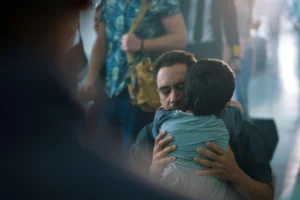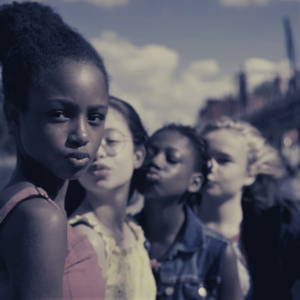It’s not a matter of if but a matter of when. If your child has access to a phone, a laptop, a computer, a tablet, a gaming station or a TV, your child has access to pornography.
Let me put that into perspective for you. If your five-year-old watches Paw Patrol on your phone, if your eight-year-old plays a game on his tablet, if you let your six-year-old have free reign with the remote to your DSTV, they can access porn. It is one click away. It’s not hard to find.
“My child is fine,” you say, “We have filtering software on all of our devices!”
That’s all good and well but, there is nothing stopping her coming across a friend’s father’s magazines. There is nothing stopping him catching a peek from a friend’s phone. There is no filtering software protecting them!
Think the chance of this happening to your child is highly unlikely? Many children have been exposed before they hit double figures – in fact halfway through primary school! I don’t know about you, but when I was eight, I was still playing with dolls, forming secret clubs with secret handshakes. Today, children are stumbling across pornographic material and some, by the age of 12, are addicted. My husband was one of them. (Read about it here.) His friend showed him some porn pictures when he was nine. He was watching hard core porn before he hit high school.
I pray that my children don’t find themselves in a situation like I’ve described. But, if they did, I would want to know that they are prepared to handle it in a way that keeps them safe rather than awakens a curiosity in the mystique.
The truth is, we have become desensitised to what surrounds us every single day! We have all seen softcore porn. Yes, even those of us who never watch TV. Come across a lingerie advert? Not porn? Could you see any part of the body that shouldn’t be exposed? Of course! That’s what lingerie is for, right? Anyone watched a ‘rom com’ lately? Did it have a sex scene – or even a very suggestive scene?
According to Merriam-Webster, pornography is defined as follows,
- the depiction of erotic behaviour (as in pictures or writing) intended to cause sexual excitement
- material (such as books or a photograph) that depicts erotic behaviour and is intended to cause sexual excitement
- the depiction of acts in a sensational manner so as to arouse a quick intense emotional reaction
Did you get that? It doesn’t have to be videos; it can be photos. It doesn’t just need to be photos; it can be books. If it causes sexual excitement, it’s porn. I don’t know a male who doesn’t feel somewhat excited by a lingerie advert.
These days, children have access to an internet world so vast that one innocent word entered into a search for a school project can summon explicit material. So we are facing a crisis that our generation didn’t experience. Children are one click away from access to hugely inappropriate material.
My question to you is this?
“Are we merely protecting our kids from temptation or are we preparing them to face temptation? If we are going to prepare them to eventually live as young adults in a world full of temptations, we need to train them to live in a world without fences, without filters.”
(Taken from Covenant Eyes)
So essentially, your job is to “install” an internal filter.
Many people may say that, by discussing such things, young children will lose their innocence. They might say, Let them be kids!
I would love nothing more than for parents not to need to have this conversation with their children. But the sad reality is that we cannot protect them from everything. They will come into contact with things we’d rather protect them from. Let me humbly suggest that we do what we can to pre-empt those situations and prepare to protect them.
Here is some information I’ve gleaned from How to Talk to Your Kids About Pornography.
- You need to have an established, open relationship where you can speak freely with your children. They need your love and your acceptance. They need a safe environment in which to confide in you.
- Be prepared. Don’t wait for the topic to come up. You should be prepared for this conversation from the time they can talk. I would suggest praying about it with your spouse and asking God for wisdom.
- Be comfortable talking about it out loud. Your embarrassment could cause your child to go elsewhere to less reliable resources and people.
- Take and use everyday opportunities. If you see a magazine, advert, or any other media – discuss it. Bath time is a brilliant time and place to start.
- Take time – Talk to them individually. Make sure you have no pressing engagements to go to. Set no time limits. Be available. Be in a neutral environment.
Maybe they have already come into contact with porn? What then?
Stay calm! Don’t jump to conclusions! Don’t accuse or shame.
- Ask questions and listen to them. Never shame or lecture. Hug them and reassure them that coming to you was the right thing to do. Ask the following:
- Do you know what pornography is?
- Have other kids spoken about it?
- Have you seen it on your own or with friends?
- What did you see?
- How did it make you feel? Excited, good, ashamed, sick?
- What do you think the man felt? What do you think the woman felt? (90% of porn is violent and objectifying woman under the guise of sexual freedom.)
- Ask if they have any questions
- It will be helpful to remind them that God still loves them and will forgive them as will you. Remind them of the story of the woman caught in adultery in John 8. Pray with them.
Now, you may ask, when should these conversations begin? In short, the sooner the better. If you have a three year-old, then what? In that case…the sooner the better!
The internet has no filter to gauge the age of the child online and it won’t be like,
“Oh, you’re only three! Let’s divert you!”
No, it will take him/her to the same page that it would a 40-year-old man – which means your child could be exposed at any time. I personally think it is possible to have a conversation about porn before you have a conversation about sex.
Begin with body awareness. Give your child the correct terminology for body parts. Use everyday opportunities such as bath time or when getting dressed.
Then tell the children that whatever a swimming costume covers is private. It’s for no one else to look at or touch. If someone does, tell someone. Ideally you’d want that person to be you!
Move on to telling your kids that it’s not okay to look at or touch anyone else’s private body parts either. At this point, you can explain that sometimes they might see pictures of people with no clothes on and it’s not okay. Or they might see people acting like they’re married (having sex) and that’s not okay! Teach them to TURN, RUN AND TELL (Taken from Good Pictures, Bad Pictures Jr.: A Simple Plan to Protect Young Minds by Kristen A. Jenson) . They need to turn away immediately, take drastic action (remove themselves) and inform an adult about where and how they came across this content. The older they are (7-11 years-old), the easier it is for them to understand the effect porn has on the brain. With children in this age bracket, use the word ‘pornography’ and explain that it comes in different forms – not only pictures but videos, books, and many other forms. None of it is okay. By this time, you should have spoken to them about sex (you want to equip them with the correct information, remember?) so they need to know that sex was created to be good! Don’t make sex dirty because it’s not! God made it good in a marriage between a man and a woman. Outside of those parameters, sex is harmful and will end up being hurtful.
It is your job to educate your children! Don’t avoid the conversation because they don’t want to have it! You are the adult!!! You get to decide when your children need to know things because you have more life experience and, believe it or not, you are also probably wiser than they are! Don’t give this massive responsibility over to anyone. Give them the correct information before the world gives them the wrong information. Equip them to make healthy choices.
There are brilliant resources out there – use them!
Here are a few to start you off:
YouTube Videos
What Should I Do When I See Pornography?
How to Talk with Your Kids About Pornography
Talking to Your Kids About Pornography
(Disclaimer: I don’t agree with everything in all of these videos but the ideas behind them are really useful!)
Books
Good Pictures, Bad Pictures: Porn-Proofing Today’s Young Kids – Kristen A. Jenson
Good Pictures, Bad Pictures Jr.: A Simple Plan to Protect Young Minds – Kristen A. Jenson
My Body Belongs to Me – Jill Starishevsky
Tags: bad pictures, body, body awareness, cell phone, child, children, computer, educate, education, father, fatherhood, filtering software, good pictures, innocence, internet, kids, laptop, marriage, mobile, mommy, mommyhood, mother, otherhood, parent, parenting, phone, porn, pornography, protect, protection, screen, screen time, sex, tablet, YouTube






Leave a Reply